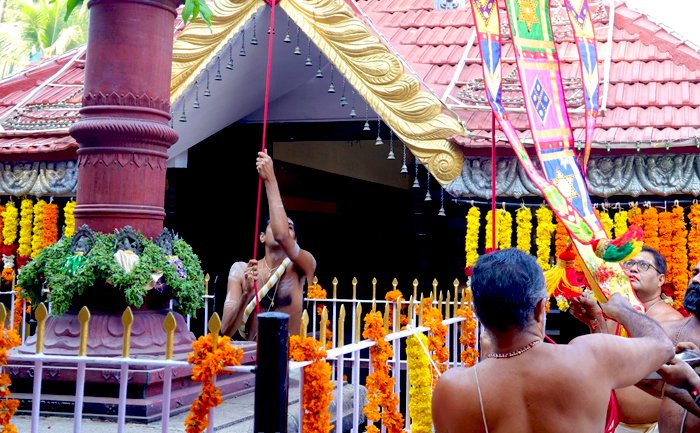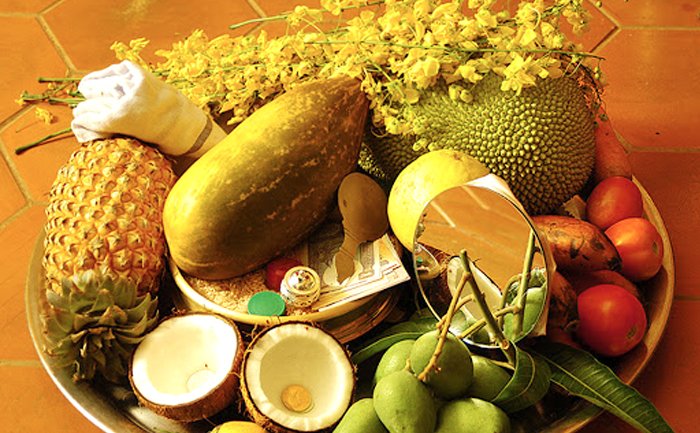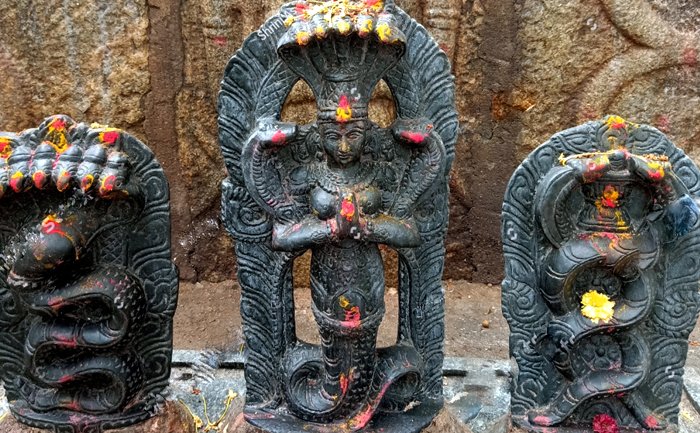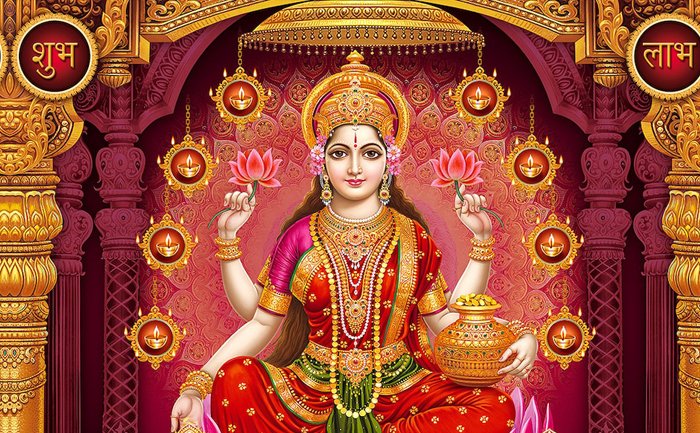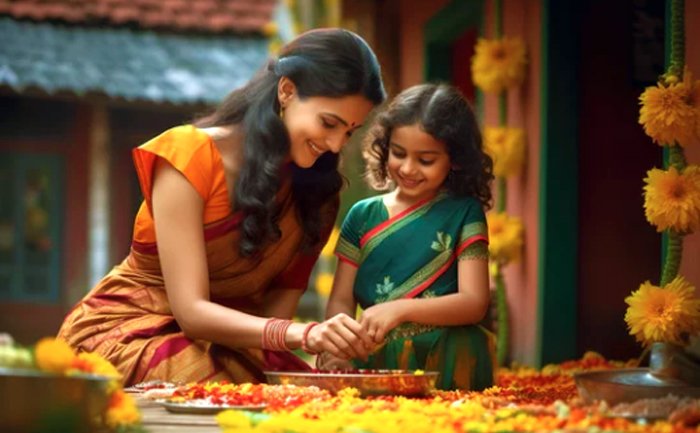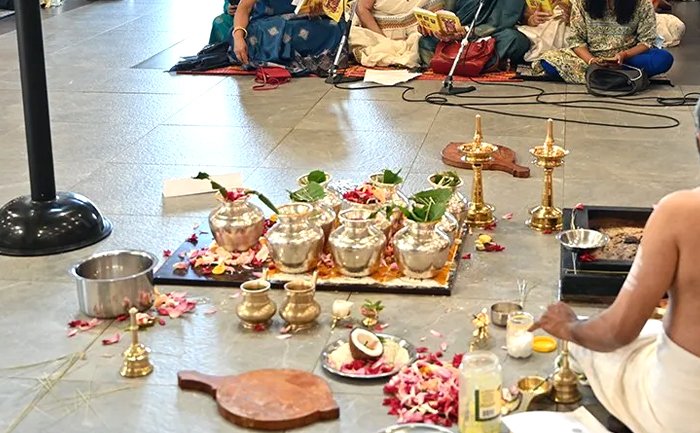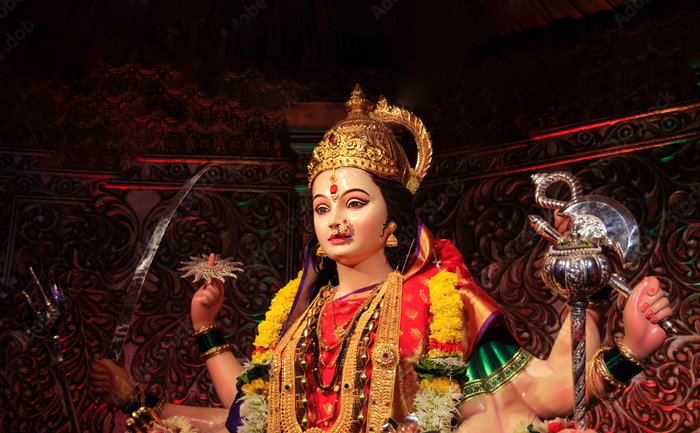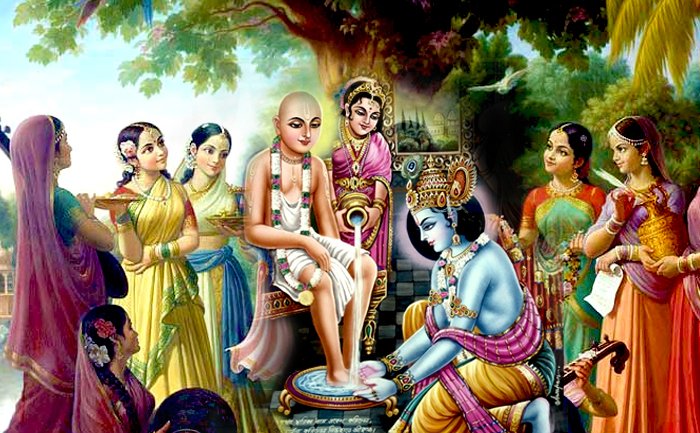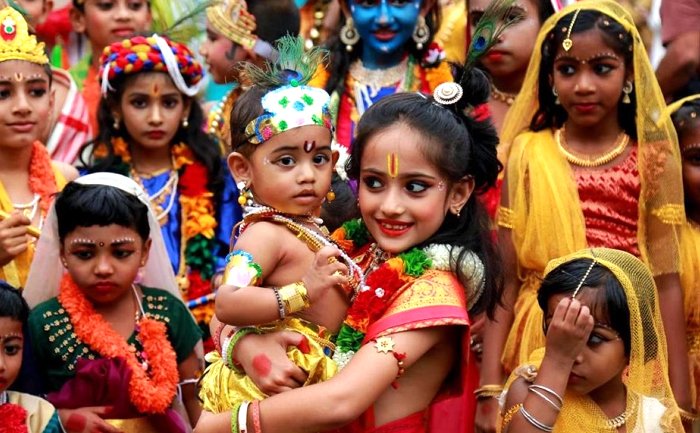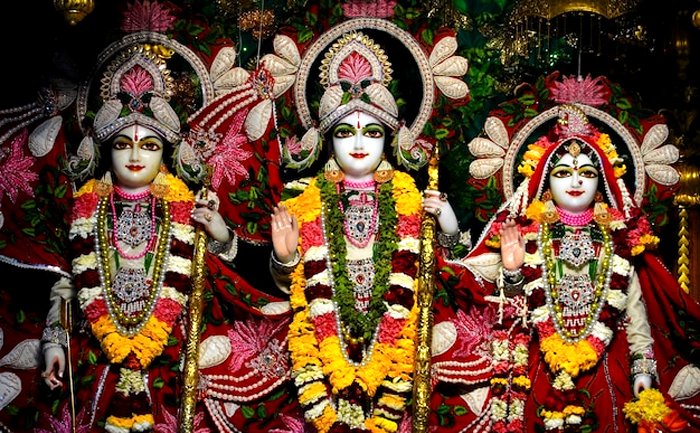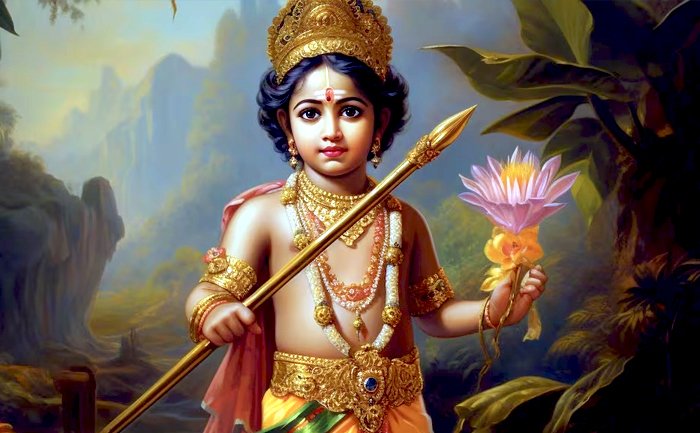- 02836-230205
- info@ayyappagandhidham-org-285065.hostingersite.com
Temple Festivals
Annual Festival
The Annual Festival Celebration starts with "Kodiyettam" (flag hoisting) on "Rohini" Nakshatra in the month of "Vrishchik" (Scorpio) every year. There are lots of special poojas during the 7 festival days.
Day - 1
Day - 2
Day - 3
Day - 4
Day - 5
Day - 6
Day - 7
Ganesh Chathurthi
Ganesha Chaturthi, also known as Vinayaka Chaturthi, is a famous Hindu festival celebrated all over India, especially in Maharashtra. It is a ten-day festival starting on the fourth day (Shukla Chaturthi) of the Bhadrapada month (mid-August-mid-September) and ending on the fourteenth day (Anant Chaturdashi) of the waxing moon. The significance of Ganesha Chaturthi is that this festival celebrates the birth of Ganesha, the god of wealth, fortune and harmony.
Ganeshotsav was started by Chhatrapati Shivaji Maharaja who was a brave and warrior king and the founder of the Maratha Empire. As Ganesha was their family deity, the Peshwas encouraged the worship and celebration of Ganesha Chaturthi in their state capital, Pune. With the fall of the Peshwas, the festival lost state patronage and became a homely celebration. Eventually, the celebration was revived as a state affair by freedom fighter Lokmanya Tilak, who used Ganeshotsav as a tool to spread the message of independence and garner public support during India's national movement for independence. As a result, it is celebrated with great vigor, enthusiasm and grandeur in the state of Maharashtra and widely in other states of India.
Vishu Celebration - Medam 1
Meda Vishu is the first day of the month of Medam in the Malayalam calendar, which usually falls on April 14 or 15 in the Gregorian calendar. It is the traditional New Year for the Malayali people, who celebrate it with various rituals and customs
It marks the spring or vernal equinox, when the day and night are of equal length. It also signifies the transition of the sun into the first zodiac sign, Aries or Meda Rashi
It is believed that the first thing one sees on the morning of Vishu determines the fortune and prosperity of the rest of the year. Therefore, people prepare a special arrangement of auspicious items, called Vishukkani, and view it as the first sight on Vishu
The Vishukkani consists of items such as rice, golden lemon, golden cucumber, coconut, jackfruit, mango, metal mirror, gold ornaments, new clothes, a holy book, a lit lamp, and the yellow flowers of the Indian laburnum (Kani Konna), which symbolize abundance, wealth, health, happiness, wisdom, and devotion
The elder members of the family also give a small amount of money or gifts to the younger ones, called Vishukkaineetam, as a token of blessing and love
People also worship Lord Vishnu or Lord Krishna on Vishu, as they are considered as the gods of time and the protectors of the universe. It is said that Lord Krishna killed the demon Narakasura on this day, and hence his idols are kept in the Vishukkani
People also enjoy a special feast called Vishu Sadya, which consists of various dishes that represent different tastes and flavors of life. The feast is served on a banana leaf and eaten with the right hand
People also celebrate Vishu by bursting firecrackers, wearing new clothes, visiting temples, exchanging greetings, and spending time with family and friends
Vishu is a festival of joy, hope, and gratitude, that celebrates the beginning of a new year and a new season. It is a time to reflect on the past, appreciate the present, and look forward to the future
Deepasthambham
Deepa Stambha is a unique piece of Hindu architectural structure, usually found in Hindu temples. As the name indicates, Deep means “diya” (“oil lamp”), Jyoti means “light,” and stambha means “a column.” Such stambhas are erected outside the temple compound, to be illuminated with diyas on special occasions.
Lighting of Deepasthambham help us removing darkness from our life.
Noornum Palum (Sarpa Pooja)
Noorum Pal is a unique ritual dedicated to Nagaraja and Nagayakshi temples in Kerala. This is one of the most important rituals in Kerala snake temples. In the ritual, special offerings are made to the Naga king and the Naga yakshi. The main ritual is to bathe the Nagamurtis in milk mixed with rice powder. After this turmeric powder is sprinkled on the nagamurtis.
For the ritual, two swastika pads are drawn on the ground. One image for Nagaraja and another for Nagayakshi. The fields are built parallel to each other.
Two idols/chitrakutam or symbolic representation of Nagaraja and Nagayakshi are placed in front of the kalams (Columns). Pujas are performed to the accompaniment of traditional musical instruments.
Banana leaves are placed near the plants during the puja. Cherukutupala, plavila, skin of banana plant, kamukin pookula and coconut pookula are placed in it. Milk mixed with rice flour, flowers, leaves and turmeric powder is offered to the Nagamurtis on that day.
The ceremony ends with tarpana, pushpanjali and deep worship.
Rituals vary from region to region.
Muppettu Velli (Bhagavati Seva)
The first Friday of the month of Makara (Capricorn) considered as "Muppettu Velli". It is believed that performing lakshmi's auspicious deeds on this day will help in recovering from financial difficulties. Even if you live with care, you may face severe financial crises sometimes. On this day, which is important for Goddess Lakshmi, chanting mantras that please Goddess Lakshmi is particularly effective.
It is best to light a ghee lamp in the evening and chant Mahalakshmi Ashtakam, Mahalakshmi Stavam and Ashtalakshmi Stotram. Recite Lalitha Sahasranama and Kanakadhara Stotram.
Ashtalakshmi Stotram is one of the most important mantras that please Lakshmi Devi. It is believed that these eight Lakshmis should be worshipped in each form. "AadiLakshmi" is the form of Lakshmi which is lit up with the Lord in vaikunta. As the name implies, "Dhaanyalakshmi" is the goddess who blesses us with good food and health. "Dhairyalakshmi" helps in instilling courage and strength in the mind. It is believed that with the blessings of "Santhanalakshmi", children with long life and good intelligence will be attained. "Vijayalakshmi" will bless to fight against any adversity in life and achieve success. The result is dhana-dhanya prosperity by "Dhanalakshmi" and education, knowledge and wisdom by "Vidyalakshmi".
Onam Celebration
Onam is a harvest festival that celebrates the return of King Mahabali. It also marks the beginning of the Malayalam year. The festival is celebrated in Kerala and by the Malayali diaspora.
Onam has great religious significance. It signifies the values of equality, prosperity, and harmony. People offer prayers to Lord Vamana and King Mahabali for the well-being of their family members.
The festival is celebrated over a period of 10 days. Some of the days that are considered important are:
Atham, Chithira, Chothi, Vishakam, Anizham, Thrikketta, Moolam, Pooradam, Uthradam, Thiruvonam
Since ancient times, various types of folk arts and sports have been performed in connection with Onam celebrations.
Onam is full of colorful pastimes like Kabaddi Kali, Kilithattu Kali, Thiruvathira Kali, Thalapanthu Kali, Vadam Vali, Puli Kali, Uriyadi, Vallam Kali, Villadichaan Paattu etc.
Onam, which evokes nostalgic memories in the minds of all Malayalis, will remain forever.
Prathishta Day
The "Prathishta Din" is celebrated every year in "Rohini" Nakshatra in the malayalam month of Edava.
Shivratri
Shivratri is the day when the black side Chaturdashi tithi (കറുത്ത പക്ഷ ചതുർദശി തിഥി) falls at midnight. Shivaratri is also the night of Lord Mahadeva. Means auspicious night. Legend has it that this is the day Lord Shiva saved the world by swallowing the poison called Kalakootam, which was capable of destroying the entire world.
It is said in the Puranas that Goddess Parvati performed Shiva bhajan without sleeping all night while holding her husband by the neck to save Lord Shiva who had drunk the Kaalakoota Poison. Therefore, it is believed that if one fasts on the day of Shivaratri and worships Lord Shiva during the night, one will get prosperity and good luck through the love of Lord Shiva.
Shivratri is celebrated on the day when the black side Chaturdashi tithi of the lunar month of Magha falls at midnight.
Navratri
Navaratri puja aims to please Durga, the goddess of knowledge and the mother of the universe. Navratri is celebrated since ancient times in Arsha Bharath. Navratri is celebrated as the victory of all good over darkness, evil and ignorance.
Navarathris (first to ninth nights of Shuklapaksha) are important in all the twelve months, but four are celebrated now. They are Sharada Navratri (Autumn season), Chaitra Navratri (Chaitra season), Ashadha Navratri (Spring season) and Vasantha Navratri (Spring season). Among them, Sarada or Sarath Navratri is the most important festival. Sarat Navratri is celebrated during the season of Sarat (September - October), the beginning of winter. It is celebrated to commemorate the slaying of Mahishasura by Goddess Durga. Although celebrated in most parts of India, it is more prominent in North India and South India. Sarat Navratri is celebrated in some parts of North India to commemorate the killing of Bandasura. Although Navratri and Devi Upasana are ages old, Navratri worship became popular only from the time of Ayodhya King Sudarshana Chakravarty. Those who rely on the feet of the Goddess without hypocrisy or futility experience eternal bliss.
Goddess pujas should be done by making a mandapam and decorating it in a holy place in the house. Those who are not able to do Nithya Pooja should do Pooja on Ashtami, Navami and Dashami days. Ashtami Puja is more special because Bhadrakali, the goddess of blessings, auspicious, beautiful and prosperous was born on Ashtami. If you do pooja, homa, annadana and kumari puja, you will get the full results of Navratri. The special feature of Devi Puja is that the devotee who serves Mahadevi in the form of Tripura Sundari gets worldly happiness and salvation after death. Even the nature is very calm during Sarat Navratri. There is no extreme heat, cold, rain or drought during these days. Because these are the days of Bhagwati Jagaran. Nowadays, staying awake all night with fasting and worshiping the Goddess is the practice of Devi Upasana in Uttar Bharath.
Kuchela Din
Ekadashi in every Malayalam month, Ashtami Rohini in Chingam, first Wednesday of Dhanu month, and Muppettu Vyazham (The first Thursday) are the most special days for Lord Vishnu. It is believed that worshiping the Lord with namajapa on these days is doubly effective. In this, the first Wednesday of the month of Dhanu is observed as Kuchela Day. It is believed to be the day when Kuchelan, who was suffering from poverty, went to his classmate Lord Sri Krishna with a bag of Aval (Rice flakes) and got blessings. It is also believed that if one visits the Lord Vishnu temple on that day and presents a bag of Aval as an offering, poverty and sorrows will be removed.
According to many texts of Hindu Purana and the believes of Hindu devotees that by offering Avalkizhi with devotion without desiring anything, we get all the blessings from the Lord Sri Krishna as given to Kuchelan..
Janmashtami
Janmashtami or Krishna Janmashtami is the birthday of Lord Sri Krishna which is celebrated with great enthusiasm and devotion in India.
Hindu belief is that Sri Krishna is the eighth incarnation of Lord Vishnu. According to knowledge from the Mahabharata, Lord Krishna was born to kill his maternal brother, the demon Kamsa. Whenever there is any imbalance in the universe regarding peace and prosperity, Lord Vishnu is said to appear in various forms to save mankind from the hands of Asuras and Adharma.
Historians and scholars say that the Lord was incarnated as the son of Vasudeva and Devaki in the prison of Kamsa during the Dwapara Yuga. But Vasudevar had to cross the river Yamuna on that stormy and torrential night to save the child from the evil hands of Kamsa and bring him to his soulmate Nandagopa. The Lord's later life was in Gokulam as the adopted son of Yashoda and Nandagopa.
The residents of Gokula saw the Lord's actions as miracles, as he easily defeated Kamsa's attempts to eliminate him from his childhood. People began to believe that this little boy named Krishna was among the common people to save them from all the tumultuous situations. Gradually, the residents of Gokula began to celebrate Krishna's birth with grandeur, as they believed this day to be auspicious.
We can undoubtedly understand that this festival initially originated from Gokulam and slowly spread to Mathura region, then Uttar Pradesh state and then across India and spread all over the world. Even now after 1000 years, the birth of Lord Krishna, the epitome of love, faith, friendship and peace, is celebrated by Hindus all over the world.
Ram Navami
Sri Rama Navami is the day to celebrate the birth of Sri Ramachandra, an incarnation of Lord Vishnu. Lord Rama was born on the Navami day of the white side of Chaitra month. This day is also known as Sri Rama Jayanti.
It is believed that fasting on this day and chanting the name of Rama is the way to attain salvation. Devotee Sita, Lakshmana and Hanuman should be meditated on not only Lord. On that day, Sarvakarya Siddhikai recites the Sundara Kanda of the Ramayana.
After waking up on the Brahma Muhurta on Sri Ram Navami, purifying the body, lighting the lamp and chanting Vishnu Gayatri.
"Sri Rama Rama Rameti Rame Rame Manorame
Sahasranamatatulyam Ramanama Varanane
Sri Ramanama Varanana Om Nama Iti. "
"ശ്രീരാമ രാമ രാമേതി രമേ രാമേ മനോരമേ
സഹസ്രനാമ തത്തുല്യം രാമനാമ വരാനനേ
ശ്രീരാമനാമ വരാനന ഓം നമ: ഇതി."
Chant this sloka 3 times which is equivalent to Vishnu Sahasra Nama Japa.
Chanting the Rama mantra throughout this day will bring prosperity and peace. Although fasting and giving up sleep are part of this fast, depending on the state of health, the fast can be observed "Orikkal" (only one meal of rice). Do not sleep during the day time. It is recommended to visit the Vishnu temple in the morning and in the evening and offer Tulasimala. On the Dashami day, one can end the fast by visiting the temple and serving theertha or Tulaseetheertha. It is believed that through this vrata ritual, one will get the results of pilgrimage to all holy places. Also the sins of previous births will be removed and will be blessed by Vishnu.
Hanuman Jayanti
Hanuman Swami's birthday is celebrated as Hanumad Jayanti. Hanumad Jayanti falls on the full moon day of Chaitra month. Hanumad Jayanti is considered to be the day when Udayal Param 6 Nazhika Pournami occurs. It is believed that offerings and prayers offered to Hanuman Swamy on that day have special results.
It is best to worship Sri Ramachandra on this day to please Hanumad. Chant or write 'Sri Ramajaya' as many times as possible for wish fulfillment.
Those who are experiencing dosha periods like Shanidasa, Shani Apharam, Kandakassani, Ashtamassani, Ezharassani and those who are suffering from work troubles can observe fast on Hanumad Jayanti day for Dosha Shanti. It is said in the Purana that Lord Shani has assured that Shanidosha will not affect the devotees of Hanumad.
The fast can be done as a full fast or as a single fast. It is said that by visiting Hanumadshetra and praying and making offerings, Vayu will get quick results. Cleanliness of the body is mandatory on the day of fasting and the day before. Do not take oil bath and sleep during the day.
Betel garland is the most important offering to Hanuman Swami. If you offer a betel leaf and pray, the result will be success in all matters and prosperity. It is also good to offer Neyvilak and Sindooram. Offering Tulasimala is good for getting rid of diseases. It is also good to offer Kadalipaja as an offering.
Chanting and listening to Hanuman Chalisa is special on this day. Chanting Chalisa is good for warding off fearful thoughts and preventing nightmares.
It is believed that by chanting the opening verses of the Hanuman Chalisa, one can get rid of the sins committed in this life and the previous life. It is said that Hanuman Swamy
will save the devotee who chants with great devotion from any kind of trouble. It is also the best way for wish fulfillment.
Hanumath Sthuthi
"Manojavam Maarutha thulya vegam
jithendriyam buddhimathaam varishtam
vaathaathmajam vaanarayoodha mukhyam
sree raama dootham sirasaa namami
Buddhir balam yasho dhairyam
nirbhayathvamarogatha
ajayyam vaak paduthvam cha
hanoomath smaranaath bhaveth"
"മനോജവം മാരുത തുല്യവേഗം
ജിതേന്ദ്രിയം ബുദ്ധിമതാം വരിഷ്ഠം
വാതാത്മജം വാനരയൂഥ മുഖ്യം
ശ്രീരാമ ദൂതം ശിരസാ നമാമി
ബുദ്ധിർ ബലം യശോധൈര്യം
നിർഭയത്വമരോഗത
അജയ്യം വാക് പടുത്വം ച
ഹനൂമത് സ്മരണാത് ഭവേത്"
Skanda Shashti
Although Shashti occurs in every month, Shuklapaksha Shashti in the month of Thulam (sometimes it may happen in Vrischika also) is considered the most auspicious.
Skanda Shashti Day is a very important day for Subrahmanyaswami. Chanting the special Guha Pancharatna stotram of the Lord on that day is very effective.
Contemplate Subrahmanyaswami in your mind and chant it carefully six times daily. Once you start chanting, don't chant expecting immediate results. Chant without expecting results. The result will surely come.
Guha Pancha RatnamOmkaara nagarastham
Nigamaantha Vaneshwaram
Nithyamekam Shivam Shaantham
Vande Guham Uma Sutham
Vaachama gocharam skandam
Chidudyaana Vihaarinam
Guru moorthim maheshaanam
Vande Guham Uma Sutham
Sachidaananda roopesham
Samsardhwaantha deepakam
Subrahmanyamanaadyantham
Vande Guham Uma Sutham
Swaaminaatham dayasindhum
Bhavaabdhe thaarakam prabhum
Nishkalankam Gunaatheetham
Vande Guham Uma Sutham
Niraakaaram Niraadhaaram
Nirvikaram Niraamaayam
Nirdwantham cha niraalambam
Vande Guham Uma Sutham
ഓങ്കാര-നഗരസ്ഥം തം
നിഗമാന്ത-വനേശ്വരം
നിത്യമേകം ശിവം ശാന്തം
വന്ദേ ഗുഹം ഉമാസുതം
വാചാമഗോചരം സ്കന്ദം
ചിദുദ്യാന-വിഹാരിണം
ഗുരുമൂര്ത്തിം മഹേശാനം
വന്ദേ ഗുഹം ഉമാസുതം
സച്ചിദാനന്ദരൂപേശം
സംസാരധ്വാന്ത-ദീപകം
സുബ്രഹ്മണ്യമനാദ്യന്തം
വന്ദേ ഗുഹം ഉമാസുതം
സ്വാമിനാഥം ദയാസിന്ധും
ഭവാബ്ധേഃ താരകം പ്രഭും
നിഷ്കളങ്കം ഗുണാതീതം
വന്ദേ ഗുഹം ഉമാസുതം
നിരാകാരം നിരാധാരം
നിര്വികാരം നിരാമയം
നിര്ദ്വന്ദ്വം ച നിരാലംബം
വന്ദേ ഗുഹം ഉമാസുതം

